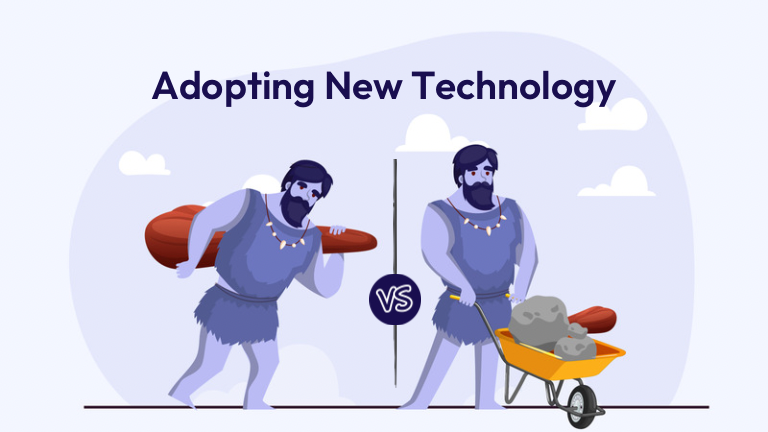(TL; DR: Adopting new technology is hard, even when it offers clear value. This post gives you a framework for adopting it.)
Back in 2018 when I was running my earlier startup, we tried adopting Slack.
It didn’t happen.
Next year, in 2019, we tried again. Worked out you think?
Nope!
In 2021, as Humantic was taking off, we were still relying mostly on WhatsApp. Not a great idea.
Finally, in 2022, we made it happen. And today, we have so many workflows running via Slack, our processes will break if Slack goes away.
Personally, I had the same struggle with adopting Grammarly. I have a habit of eating my articles, especially ‘the’, and I am generally finicky about language. The experience was intrusive, and I would give up within days of starting out. “It’s lousy UX” was my reasoning. Till one day, I promised myself that come what may, I would not stop using it for a month. And then I will decide if the intrusion is worth the value.
I have been a user for 2+ years now. I write better emails, make fewer embarrassing mistakes, and I’ve gotten more effective at communication in general.
Right now, I am facing the same challenge with our team’s adoption of video prospecting. There is too much inertia, but I can’t stop till they do. As a team leader, it’s my responsibility to look into the future and see what will keep going up in value. It’s not their job.
Adopting new tools earlier than others has a multiplier effect. Why would I slow down on something that’s going to give us an edge over every other vendor out there?
The problem becomes especially acute when adopting cutting-edge technology. I see 8 out of 10 of our buyers struggling with it every day. It’s a bit like Edge Of Tomorrow – if you have seen that Tom Cruise movie.
If you are a business leader struggling with the adoption of new technology, these are the 3 pits that you are falling in.
1. Not evaluating innovative technology
If the only tools and tech you adopt are those that are already proven, you will get 0 (zero) competitive advantage out of the millions that you spend on tools.
It’s like waiting to be 40 before buying a superbike instead of getting it at 21. Low-risk, but very low value.
In his new book titled ‘The Sales Innovation Paradox’, Dr. Howard Hoover of University of Texas at Dallas explains how sales leaders keep doubling down on the same old bad technology in their quest for doing ‘more’ of the same instead of adopting innovations that will help them do ‘better’.
I recommend reading that book by the way.
What to do
Make new tech 20-40% of your tool mix (depending upon your risk appetite). So if you evaluate 10 new tools next year, 2 to 4 of them should be not yet fully proven tech.
2. Leaving it to the support teams
In sales, too often I see the CRO passing evaluation of new tech to sales operations or enablement teams. This is a brilliant call when you are adopting a new CRM, but is it equally brilliant if you are adopting generative AI?
You are the leader because your eyesight is supposed to be 20/20. Because you can see farther than most.
It’s good to have them help, coordinate and manage, it’s another thing to leave the decision entirely to them. Technology is going to be the single largest differentiator for every single business on the planet (it probably already is). As Gartner says, sales leaders need to become leaders of selling, not of sellers.
Not making the decision yourself is like a CEO leaving a recession year’s strategy to the CFO. We all know how that ends.
What to do
When it comes to anything new and risky but valuable (like cutting-edge technology), roll up your sleeves. It is worth your time. Additionally, ask your top reps. Odds are that they are already using it.
3. Expecting too much too soon
Did Tom Brady look like he was going to be one of the greatest quarterbacks ever when he was 16? Or did computerization solve all process problems in 2000?
New technologies take some time. A buyer intelligence tool like Humantic AI for example doesn’t have a playbook as comprehensive as, say, Salesforce. Maximizing value from it will take slightly longer than established tools.
Imagine being Steve Mariucci, the 49ers coach who said no to Brady because he looked at what he could do then. Or being Bill Belichick, who saw what Tom Brady could be.
What to do
Evaluate new tech thoroughly, and move ahead only if you come to have belief. However, give it more space than others. Hypothetically, if you purchase a new tool if it scores 8/10 during a trial, then purchase new technology even if it scores 20% lower - it simply takes more time. Odds are very high that within 6-12 months, it will become a 8.5 or even a 9/10 tool. New technology matures fast, and your team will quickly build expertise as well.



